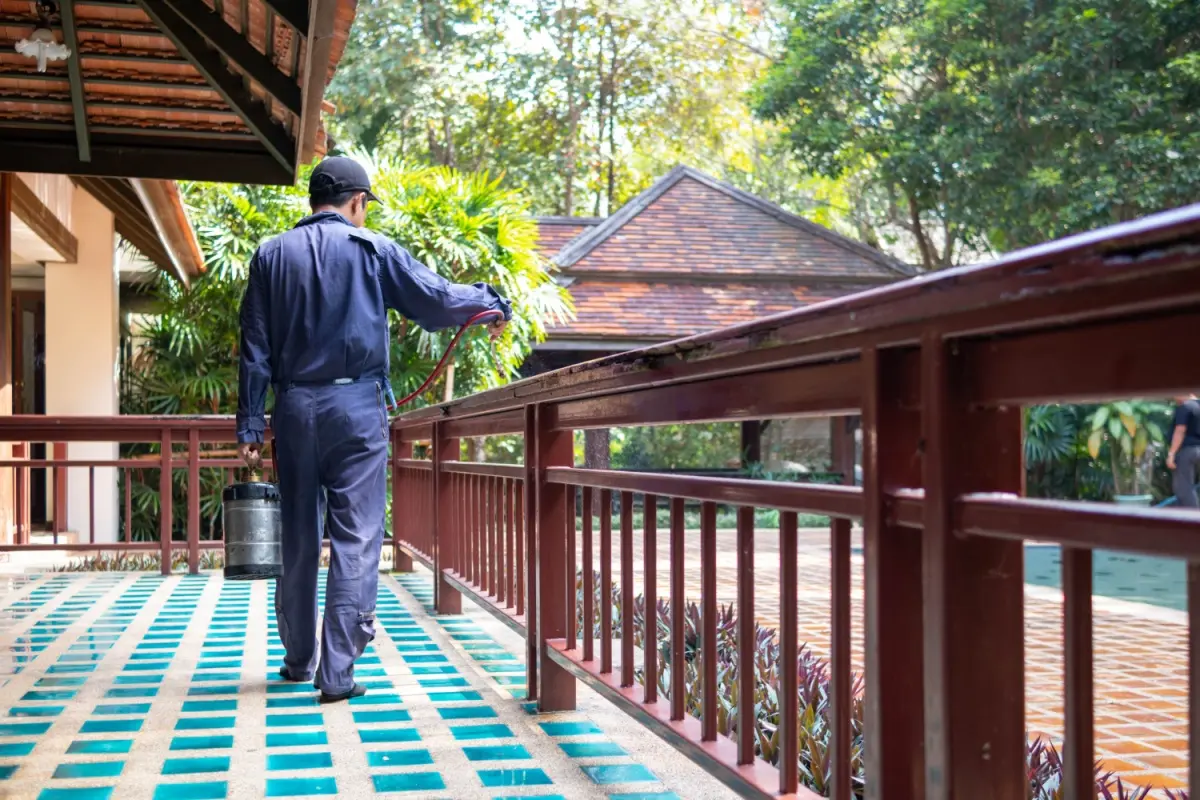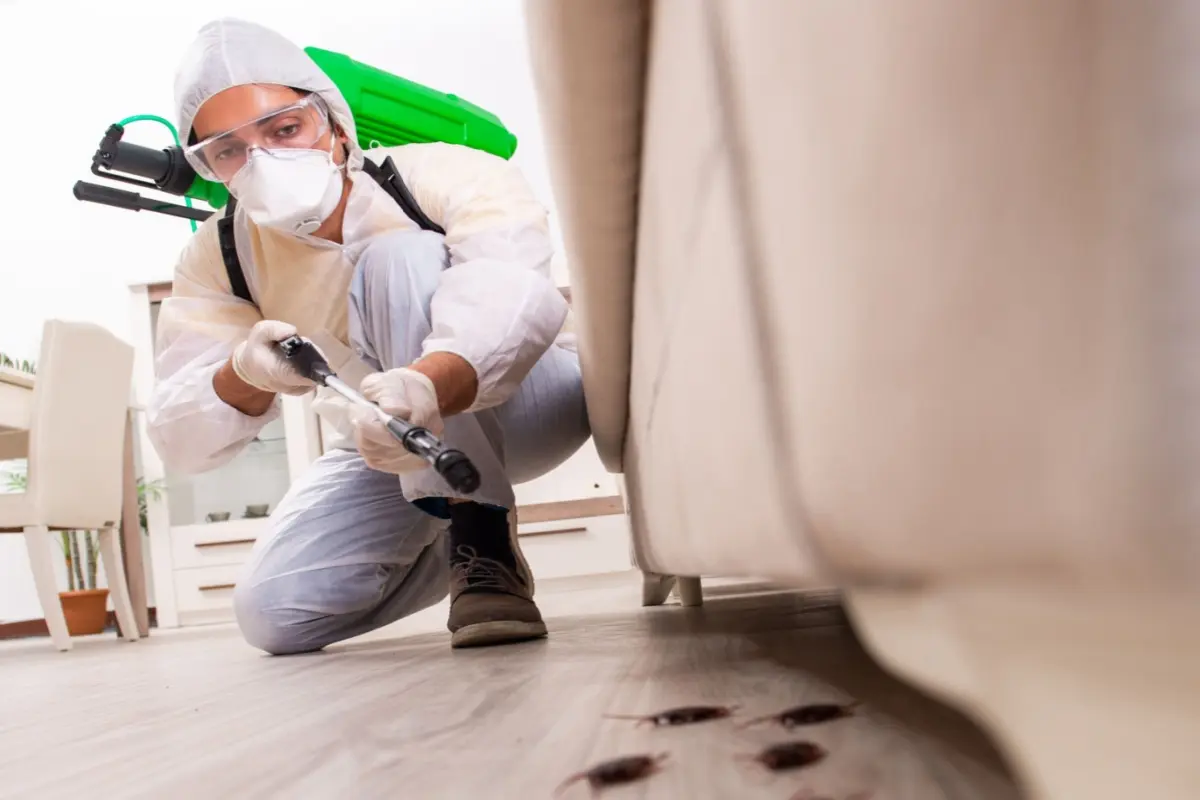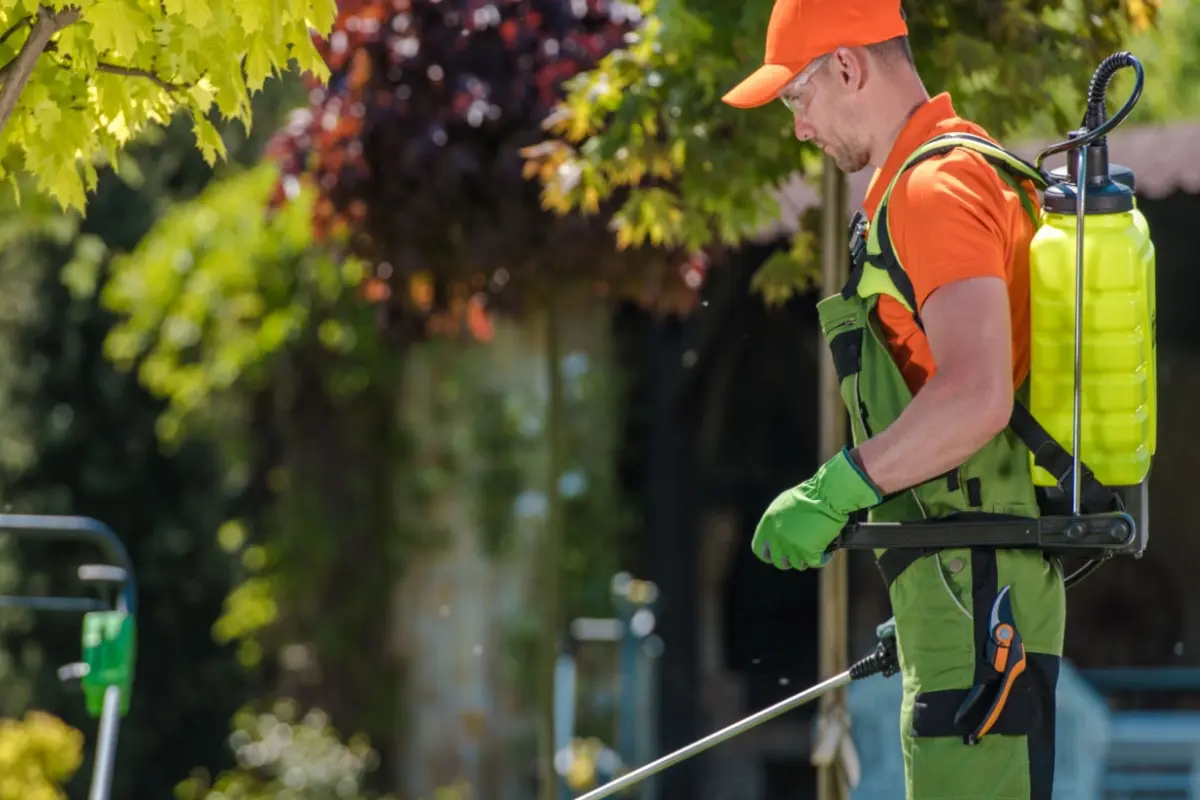Now that you’ve learned how to start a pest control business and legally set up your company, you’re likely wondering what tools and chemicals you’ll need to start offering services.
What do pest control companies use to treat infestations? Below, we highlight some must-have tools and chemicals for common infestations and specialty services.
What Are the Most Effective Pest Control Methods?
The most common types of pest control fall into three main categories, each used to address different problems: physical, chemical, and biological. Let’s learn how each method works and when they are most effective.

Please note that some of these methods may be cost-prohibitive to your customers. However, if you offer pest control financing, your customers will be able to get the services they need now while paying for them over time.
Physical Pest Control Methods
Equipment and barriers like traps and temperature control methods can help physically prevent pests from entering or staying indoors. Plus, these methods don’t use chemicals or pesticides, so they’re safer for the environment and non-target species like humans and pets.
Traps
Traps are most effective for controlling smaller pest populations and new infestations in high-traffic areas. Here are the different types of traps most commonly used:
- Snap traps use a spring-loaded bar to catch and kill rodents like mice and rats quickly. They are best used in areas with high rodent activity, such as kitchens or storage rooms.
- Glue traps are flat boards coated with a sticky substance that holds insects or small rodents when they walk across them. They are often placed in basements and attics.
- Electronic traps use a high-voltage shock to kill rodents, which many deem a more humane method. They are often placed along walls or in corners where rodents travel.
- Live traps are cage-like devices designed to humanely catch larger rodents or animals and release them safely elsewhere.
- UV flashlight traps use light to lure insects into the trap and confine them to sticky pads or an electric grid. These traps are used in indoor environments such as restaurants, warehouses, and homes, where flying insects like flies, moths, and mosquitoes are a problem.
Barriers
Barriers prevent pests of all sizes from entering houses, apartments, or buildings. They are most effective when used as a preventative measure before infestations start. There are different types of barriers:

- Screens are placed on windows and doors to keep flying insects, such as mosquitoes and flies, out of buildings.
- Nets are used on plants and trees to protect crops from birds, large insects, and even deer. The cover creates a physical barrier that prevents pests from reaching them.
- Caulking seals cracks and crevices, preventing ants, cockroaches, and spiders from entering.
Temperature Control
Extreme heat or cold can also kill pests by creating an inhospitable environment for them to grow or thrive. Let’s take a closer look:
- Adding heat to enclosed spaces such as homes, warehouses, and greenhouses can kill pests like bed bugs, termites, and other insects. Temperatures of 120°F and above are best.
- Adding cold temperatures below 32°F can eliminate pests like beetles and moths by disrupting their cellular processes. Cold treatments are typically used in food storage facilities and shipping containers housing perishable goods.
Biological Pest Control Methods
One environmentally-friendly option for pest control includes using natural predators, parasites, or pathogens as a proactive measure. Here’s a closer look at biological pest control:
Natural Predators
Introducing natural predators that hunt and consume pests can help keep pest populations in check without introducing chemicals or disturbing the environment. This is especially useful in agricultural and garden settings.
- Ladybugs are the enemy of aphids, scale insects, and mites. A single ladybug can eat up to 60 bugs per day, helping combat infestations in gardens, greenhouses, and agricultural fields. You’ll need to release them in large numbers for better impact.
- Lacewings and their larvae target aphids, caterpillars, and other soft-bodied insects. When released on farm fields and in greenhouses, adult lacewings, and their hatched eggs will eat bugs and attack a pest control problem naturally.
Biopesticides
Chemicals derived from natural materials like plants, bacteria, and certain minerals are safer than synthetic chemicals because they target specific pests without harming other organisms. Biopesticides are less toxic to humans and pets and beneficial to insects like bees. They’re also eco-friendly because they break down more quickly in the environment.
- Bacillus thuringiensis (Bti) is a natural bacteria lethal to certain insect larvae, such as caterpillars, mosquitos, and some beetles. When ingested, the bacteria disrupt the gut lining, causing the pests to stop feeding and die within minutes. Most importantly, it’s non-toxic to plants and humans, so you can apply it directly to affected plants and water sources to fight infestations.
- Neem oil is often used in organic farming and gardening to disrupt the pests’ hormones, preventing them from feeding, growing, or reproducing. When applied as a foliar spray or soil drench, it immediately repels whiteflies, aphids, Japanese beetles, moth larvae, and spider mites. Neem oil is safe for humans, pets, and non-target species.
- Entomopathogenic nematodes are microscopic worms that infect and kill insect larvae in the soil using bacteria they release upon contact. They attack like root weevils, grubs, and fungus gnats. Mixed with water and applied directly to the soil, entomopathogenic nematodes are safe for humans, pets, and non-target species.
Chemical Pest Control Methods
For larger pest problems, professionals lean on chemical pest control products to either eliminate or deter pests. However, proper application is important for keeping pets, kids, and other creatures safe. Here’s a deeper dive into each type:
Insecticides
Widely used in residential and agricultural settings, insecticides are a near-immediate pest control strategy. There are different types of insecticides:
- Pyrethroids are a mixture of chemicals, some of which are found naturally in chrysanthemum flowers, that control mosquitoes, flies, and roaches. They’re often administered via a fog or spray to fight a broad spectrum of insects by attacking their nervous systems. Pyrethrins are low in toxicity to people and other mammals, but they’re highly toxic to bees and fish.
- Neonicotinoids suppress a variety of tree, crop, and ornamental plant insect pests by attaching to their receptors and paralyzing them upon absorption. These nicotine-like chemicals are most commonly used to protect crops from pests like aphids, whiteflies, and beetles, and are usually applied directly to the soil.
- Insect Growth Regulators (IGRs) disrupt pests’ natural reproduction cycle, halting growth and development. While IGRs won’t kill insects immediately, they can stop a pest population from reproducing, making them an effective preventative measure for controlling cockroaches, fleas, and mosquitoes.
Rodenticides
Pest control companies use rodenticides for heavy rodent infestations that pose a significant health risk or cause substantial property damage. Here are the most used types of pesticides for rodents:
- Anticoagulants, such as warfarin and bromadiolone, are slow-acting chemicals that prevent blood clotting, slowly killing the rodent as they continue to consume the product. They are used primarily against rats and mice in urban areas, warehouses, and agricultural settings. However, there is a risk of secondary poisoning by predators that eat the affected rodents.
- Non-anticoagulants, like bromethalin and cholecalciferol, damage rodents’ nervous systems or calcium levels upon consumption. They are more potent, often requiring just a single dose to be lethal. However, they are toxic to humans and non-target species in high exposure, so careful administration is key. Non-anticoagulants are most successful in targeting rats, mice, and squirrels that don’t respond to anticoagulants.
Termiticides
For termite pest control, companies may use termiticides to protect structures from termite damage. Let’s dive deeper:
- Soil treatments, like fipronil and imidacloprid, are applied directly to the ground around and under a building to create a chemical barrier. They are long-term prevention and treatment strategies that are especially effective against subterranean termite infestations that build colonies in the soil and invade from below. If the termite crosses the barrier, the chemical kills them.
- Wood treatments, or borate-based termiticides, protect wood structures from termite damage by repelling them or killing active infestations once ingested. They combat dry wood and damp wood termites, which infest wood directly without needing soil contact. You can also combine wood treatments with other pest control methods to fight more aggressive infestations.
4 Essential Tools for Pest Control Technicians
Like any other job, pest control technicians need the right tools to handle pest problems effectively. Here are some essential tools for pest control that every professional should have on their truck:
Foamer
Foamers are used to apply foaming agents that expand and fill voids where pests hide. These include areas that liquid treatments might miss, like inside wall voids, under slabs, and attics. The foaming agent is mixed with an insecticide and then applied using the former.
The price of a foamer is about $120 for a basic foamer up to $300 or more for higher-end models with larger capacities and additional features like adjustable flow rates and multiple nozzle attachments.
Duster
Dusters are used to apply insecticide formulations to cracks, crevices, and voids. They commonly target bed bugs in mattress seams, ants in wall voids, and cockroaches in kitchen appliances.
They also treat nests of stinging insects like wasps and hornets. Depending on the model, dusters cost between $20 and $50.
Hose and Chemical Sprayer
Hose and chemical sprayers are used to apply liquid insecticides over large areas, such as lawns, gardens, and the exterior of buildings. They are also used for large indoor areas, such as warehouses and industrial spaces.
Hose and chemical sprayers can cost anywhere from $50 to $200. Basic models with smaller tanks are more affordable and meant for small-scale use. Larger, sturdier models with higher pressure ratings and adjustable spray patterns fall on the higher end of the spectrum.
Bait Tools
Bait guns and systems attract and kill pests, particularly ants, roaches, and rodents using consumable “bait.” You can place the bait where pests are active, such as along trails, near nests, or in concealed spaces.
When pests consume the bait, they carry it back to their colonies or nests, which helps eliminate even more of the population.
Simple bait tools typically cost around $30. More advanced ones with tamper-proof designs and monitoring capabilities can cost around $100. These are great for high-risk or busy areas like food processing plants, hospitals, and schools.
Safety Precautions to Consider When Using Chemicals for Pest Control
Pest control chemicals can cause serious health issues if not handled properly. Harsh chemicals can expose pets and people to risks because they can cause skin burns, respiratory issues, and other health problems if not handled properly. When using herbicides, pesticides, or chemicals for pest control, consider these key safety tips:

Proper Handling and Storage
Invest in appropriate protective equipment for your technicians, such as gloves, goggles, respirators, and protective clothing. This will help them avoid making direct contact with chemicals and inhaling fumes.
Ensure each chemical container is labeled and stored in a secure, well-ventilated area, away from direct sunlight and extreme temperatures. They should also be kept out of reach of children and pets.
Lastly, always follow the manufacturer’s instructions for mixing and applying chemicals. Use designated measuring tools and thoroughly clean pest control equipment to prevent cross-contamination.
Technicians should also know emergency procedures when handling pest control materials, such as first aid for chemical exposure and how to contact emergency services.
Environmental Impact
Chemicals can be extremely harsh to the environment and harm insects indispensable to our ecosystem, like bees and butterflies. To minimize the environmental impact and minimize exposure, apply chemicals carefully, use targeted treatments, and avoid spraying near water sources to prevent contamination of rivers, lakes, and groundwater.
Regulations and Compliance
Make sure you adhere to local and national regulations for safe and legal pest control practices. Regulations vary by region but typically include chemical registration, usage, application methods, and disposal guidelines.
For instance, the Environmental Protection Agency (EPA) oversees pesticide regulations, while the Occupational Safety and Health Administration (OSHA) provides guidelines on workplace safety.
Technicians should also undergo certification and training programs to stay current on regulations and best practices. Many states, like California, Texas, Florida, and New York, require pest control professionals to maintain a valid operating license earned by passing an exam and taking ongoing educational courses.
Safe Disposal
Learn how to properly dispose of your chemical containers and unused products to prevent environmental contamination and human exposure. The EPA and state agricultural departments require that you triple-rinse empty containers before disposal. Some states, like California and Florida, offer pesticide container recycling programs.
Conversely, unused or expired chemicals should be taken to designated hazardous waste disposal facilities. Never pour chemicals down the drain or into the soil.
Lastly, keep detailed chemical usage records, including dates, quantities, locations, and incidents. This information helps comply with regulations and address health or environmental issues like accidental spills, contamination, or exposure incidents.
If you are ever unsure about how to use pest control chemicals safely, then take the time to learn the proper methods from a professional.
Benefits of Using Chemicals for Pest Control
Homeowners may be leery of using chemicals as a pest control method, but they are the preferred choice for professional remediation.
Let’s take a look at the benefits of using chemical treatments:
- Quick action: Chemical treatments act fast once applied, which is beneficial when the pests pose a significant health risk or cause substantial property damage.
- Broad spectrum use: Many chemicals, such as pyrethroids, neonicotinoids, organophosphates, and carbamates, are effective against a variety of pests. This reduces the need to buy multiple insecticides and rodenticides.
- Long-lasting prevention: Chemicals remain active for extended periods after application, so you won’t have to repeat treatments as often.
- Affordability: Chemical treatments can be more cost-effective than other pest control methods, as they require smaller amounts to accomplish the job.
- Targeted application: Using a sprayer, duster, or foamer, chemicals can be applied to specific areas or pests, such as trails and nests, to reduce the impact on non-target organisms and the environment.
- Flexibility: Chemicals are available in various formulations and can be tailored to the specific infestation. This allows you to pick the best option for the homeowner, whether it’s a liquid spray, dust, or bait.
- Customized solutions: Chemicals can be combined with other pest control methods (physical and biological) to improve overall effectiveness.
- Enhanced safety formulations: Modern chemical technology makes chemicals less toxic to humans and non-target animals while being very effective against pests.
Pest control isn’t just about getting rid of pests; it’s about doing it efficiently and safely. With the tools and chemicals covered above, you’ll be well-equipped to offer your clients a range of services to help treat all their pest control needs.
FAQ
What Do Exterminators Use for Roaches?
Exterminators often use a combination of baits, sprays, and dust to target roaches. In particular, gel baits containing insecticides like fipronil or hydramethylnon have proven to be most effective.
What Do Pest Control Companies Use for Ants?
Baits containing boric acid or hydramethylnon and perimeter sprays to target ants are common ways pest control companies combat ant infestations.
What Do Pest Control Companies Use for Mice?
Mice can be controlled with a combination of traps and rodenticides. Snap traps, electronic traps, and anticoagulant baits are common.
What Chemical Do Pest Control Companies Use for Mosquitoes?
Companies spray or fog insecticides like pyrethroids to control mosquitoes. To tackle the problem at its source, companies might also use larvicides in standing water to stop mosquito larvae from growing into adults.
What Chemical Do Pest Control Companies Use for Spiders?
Spiders are typically controlled using residual sprays containing pyrethroids, which are applied to areas where they are often found.
What Do Pest Control Companies Use for Fleas?
To control fleas, technicians use insecticides like pyrethrins or imidacloprid applied using sprays and foggers. Pest control companies might also use insect growth regulators (IGRs) like methoprene or pyriproxyfen. These IGRs stop flea eggs from hatching and prevent larvae from becoming adults.Now that you’ve learned how to start a pest control business and legally set up your company, you’re likely wondering what tools and chemicals you’ll need to start offering services.


